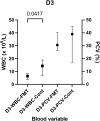Effects of fecal microbiota transplantation on clinical outcomes and fecal microbiota of foals with diarrhea
- PMID: 39266472
- PMCID: PMC11423448
- DOI: 10.1111/jvim.17185
Effects of fecal microbiota transplantation on clinical outcomes and fecal microbiota of foals with diarrhea
Abstract
Background: Diarrhea in foals can be associated with disruption of the intestinal microbiota (dysbiosis). Effective management of intestinal dysbiosis in foals has not been demonstrated.
Hypothesis/objectives: Fecal microbiota transplantation (FMT) in foals with diarrhea influences the intestinal microbiota and improves clinical and clinicopathological outcomes.
Animals: Twenty-five foals <6 months of age with diarrhea and systemic inflammatory response syndrome at 3 veterinary hospitals.
Methods: A prospective randomized placebo-controlled cohort study. Foals in the FMT group (n = 19) or control group (n = 9) received FMT or electrolyte solution once daily for 3 days. Fecal samples were obtained on Day 0 (D0), D1, D2, D3, and D7. Within group and between group data analyses were performed for clinical, clinicopathological, and microbiota variables.
Results: Treatment had no effect on survival (FMT 79%; control 100%, P = .3) or resolution of diarrhea (FMT 68%; control 55%, P = .4). On D3, the white blood cell count of the FMT group was lower than the control group (D3 FMT group median 6.4 g/L [5-8.3 g/L]; D3 control group median 14.3 g/L [6.7-18.9 g/L] P = .04). Heart rate reduced over time in the FMT group (D0 median 80 bpm [60-150 bpm]; D2 median 70 bpm [52-110 bpm] [P = .005]; and D3 median 64, [54-102 bpm] [P < .001]). Phylum Verrucomicrobiota, genus Akkermansia, and family Prevotellaceae were enriched in the FMT group on D1 (linear discriminate analysis > 4).
Conclusions and clinical importance: In foals with diarrhea, FMT appears safe and can be associated with some clinical and microbiota changes suggestive of beneficial effect.
Keywords: foal; next‐generation sequencing; transplant.
© 2024 The Author(s). Journal of Veterinary Internal Medicine published by Wiley Periodicals LLC on behalf of American College of Veterinary Internal Medicine.
Conflict of interest statement
Kristopher J. Hughes serves as Associate Editor for the Journal of Veterinary Internal Medicine. He was not involved in review of this manuscript. No other authors declare a conflict of interest.
Figures








Similar articles
-
The fecal microbiota of healthy donor horses and geriatric recipients undergoing fecal microbial transplantation for the treatment of diarrhea.PLoS One. 2020 Mar 10;15(3):e0230148. doi: 10.1371/journal.pone.0230148. eCollection 2020. PLoS One. 2020. PMID: 32155205 Free PMC article.
-
Simultaneous Daily Fecal Microbiota Transplantation Fails to Prevent Metronidazole-Induced Dysbiosis of Equine Gut Microbiota.J Equine Vet Sci. 2022 Jul;114:104004. doi: 10.1016/j.jevs.2022.104004. Epub 2022 May 6. J Equine Vet Sci. 2022. PMID: 35526726
-
Assessment of clinical and microbiota responses to fecal microbial transplantation in adult horses with diarrhea.PLoS One. 2021 Jan 14;16(1):e0244381. doi: 10.1371/journal.pone.0244381. eCollection 2021. PLoS One. 2021. PMID: 33444319 Free PMC article.
-
Fecal Microbiota Transplantation in Dogs.Vet Clin North Am Small Anim Pract. 2021 Jan;51(1):219-233. doi: 10.1016/j.cvsm.2020.09.012. Epub 2020 Oct 29. Vet Clin North Am Small Anim Pract. 2021. PMID: 33131919 Review.
-
Fecal Microbiota Transplantation for the Critically Ill Patient.Nutr Clin Pract. 2019 Feb;34(1):73-79. doi: 10.1002/ncp.10228. Epub 2018 Dec 18. Nutr Clin Pract. 2019. PMID: 30561131 Review.
Cited by
-
Impact of fecal microbiota transplantation in dogs.Front Vet Sci. 2025 Jul 1;12:1505226. doi: 10.3389/fvets.2025.1505226. eCollection 2025. Front Vet Sci. 2025. PMID: 40666732 Free PMC article.
References
MeSH terms
Grants and funding
LinkOut - more resources
Full Text Sources
Medical

